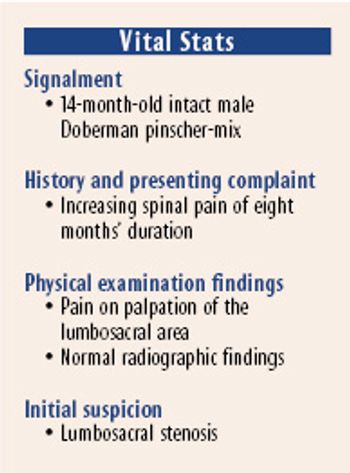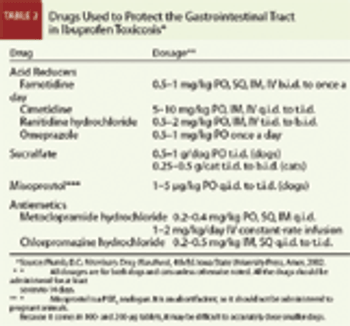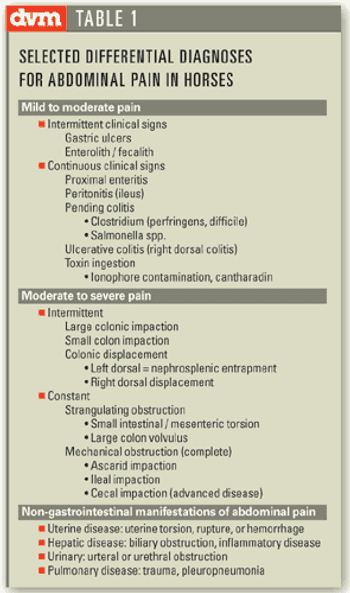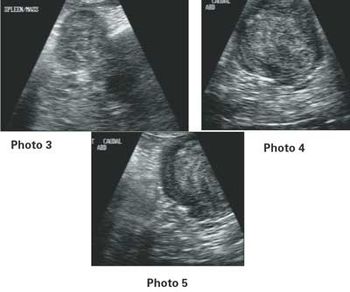
Capnographs are noninvasive monitoring tools used to estimate arterial carbon dioxide tension in anesthetized patients by sampling the patients' expired air.

Capnographs are noninvasive monitoring tools used to estimate arterial carbon dioxide tension in anesthetized patients by sampling the patients' expired air.

Local anesthesia and regional anesthetic nerve blocks have been used for decades in human dentistry, but incorporating intraoral regional anesthetic blocks into veterinary dental and oral surgical procedures did not gain acceptance until the mid-1990s.

Injectable Anesthesia Update Sponsored by an educational grant from Fort Dodge Animal Health

A 14-month-old intact male Doberman pinscher-mix was presented to Texas A&M University's Texas Veterinary Medical Center for evaluation of chronic spinal pain and lameness.

We have isoflurane and sevoflurane vaporizers on the same anesthetic machines.

A nonsteroidal anti-inflammatory drug derived from propionic acid, ibuprofen has analgesic, anti-inflammatory, and antipyretic effects.

The authors of this study concluded that etodolac therapy should be discontinued before thyroid function testing in dogs.

Practitioners might soon rely on a new procedure to alleviate severe chronic pain resulting from cancer, osteoarthritis or surgery. Resiniferatoxin (RTX), first isolated in the 1970s, has been administered during a series of clinical studies to kill specific nerve cells while leaving others untouched.

Disappointed clients rarely sue veterinarians. Neither do sad clients. Clients who sue are shocked clients ...

Tacoma, Wash.-In an unprecedented ruling, the Washington Court of Appeals has determined how much pain is needed for an animal cruelty conviction.

Las Vegas-Industry leaders just formed the International Veterinary Academy of Pain Management (IVAPM) to increase awareness, recognition and treatment of animal pain by educating students, veterinarians and hospital staff members.

Q. Please provide educational material about canine chronic pain management for the client that is not commercially prepared.

Any good training program starts with standardization of procedures so they can be taught and readily duplicated by staff members. Consistency of process is an asset anywhere in your practice but especially in the prep room and surgery.

Recently I was visiting with a friend who is still in clinical practice, and our talk turned to emergency duty.

Colic, or abdominal pain, is a relatively common problem that develops in horses of all ages. Practitioners in the field of equine medicine should be familiar with the various conditions that can contribute to abdominal pain. Once a clinical evaluation has been performed the practitioner will be able to narrow the differential list to establish a working diagnosis.

The most common toxicity presenting at our referral center is pyrethroid exposure in felines.

Private practitioners favor less anesthetic drugs, perform more outpatient procedures and rarely check blood pressure in anesthetized animals compared to their public university counterparts.

W e have all been there. A client calls to say that she has just found her horse standing in the field unwilling to move.

Treatment of painful conditions in horses has relied largely on nonsteroidal anti-inflammatory drugs (NSAIDs) for much of the last 25 years. For example, flunixin meglumine (Banamine®) and phenylbutazone (Butazolidin®) have dominated the market for treatment of colic and lameness respectively. However, it is becoming increasingly clear that these drugs also have some side effects, most notably gastrointestinal ulceration.

Signalment: Canine, mixed breed, 10-year-old, male castrated, 88 lbs.

How does your staff handle client grief?

Madison, Wis. - University of Wisconsin researchers think they might have the answer to why some dogs die after receiving anesthesia for surgery.